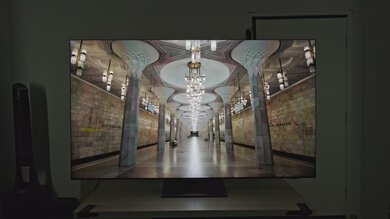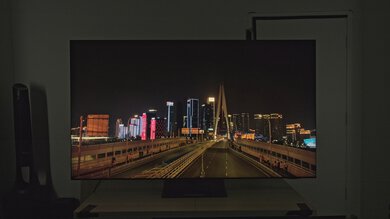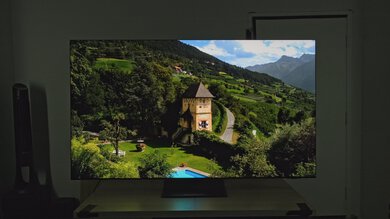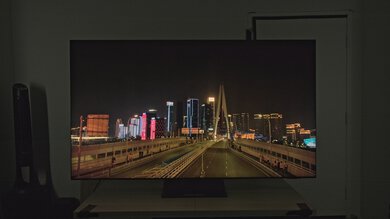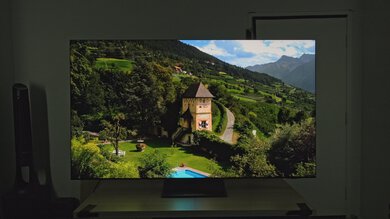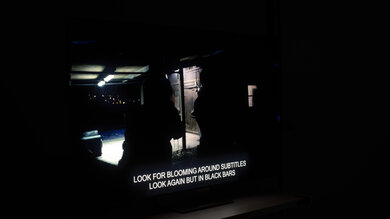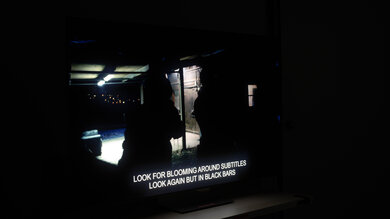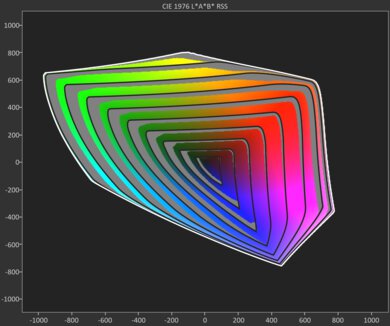The Samsung QN900D 8k QLED is Samsung's 2024 flagship 8k option that sits above the Samsung QN800D 8k QLED. The TV replaces the Samsung QN900C 8k QLED and features Samsung's proprietary Quantum Matrix Technology Pro, which allows for more precise control of the TV's local dimming zones when compared to their regular Quantum Matrix Technology. It supports 8k @ 60Hz on all four of its HDMI 2.1 ports, but it's also capable of up to 4k @ 240Hz, with full VRR functionality. It utilizes the latest NQ8 AI Gen3 Processor, which is said to be at least twice as fast as the processor used in Samsung's 2024 4k Neo QLED TVs, leading to better upscaling performance in general. Like many of Samsung's super high-end offerings, the TV uses the external One Connect Box to help keep your setup tidy and organized. It uses the 2024 version of Samsung's Tizen OS. We bought and tested the 65-inch model, but it's also available in 75 and 85-inch sizes. It's been replaced in 2025 by the Samsung QN900F QLED, and there's also a higher-end model with a Wireless One Connect box, the Samsung QN990F 8K TV.
Our Verdict
The Samsung QN900D is very good for mixed usage. It's very good when you have lights on in your room since it's very bright in SDR and easily overcomes glare from indirect lighting. It also does an adequate job of lessening the intensity of direct reflections. It looks very good in a dark room, too, with very deep blacks and minimal blooming around highlights. Highlights and colors in HDR content are punchy, leading to an impactful HDR experience whether you're watching shows, movies, or playing games. Speaking of gaming, this is a fully-featured gaming TV, although it's held back by its lack of clarity in fast motion. Finally, its viewing angle is okay if you're watching from a slight angle, but the image doesn't hold up well in wide seating arrangements.
Great black levels with minimal blooming.
Great HDR brightness for impactful highlights.
Excellent SDR brightness helps it overcome glare in a well-lit room.
Colors in HDR content are bright and vibrant.
Slow pixel transitions in Game Mode leads to blurry motion.
The Samsung QN900D is very good for a home theater. The TV has great black levels due to its effective local dimming solution, giving it very deep blacks in a dark room with minimal blooming around bright elements. The TV displays vibrant colors with solid accuracy, and it respects the filmmakers' intent when it comes to the brightness of HDR content. Highlights in HDR content also pop out very well, thanks to its great HDR brightness. It has great upscaling, which is extra important for an 8k model since most content will need to be upscaled. However, its low-quality content smoothing is mediocre, and there are still visible artifacts present in low bitrate content and a loss of detail. The TV has some minor stutter, but not everyone will even notice it. Unfortunately, it doesn't support the popular Dolby Vision HDR format and doesn't passthrough DTS audio formats, which is a drawback for those with a 4k Blu-ray collection.
Great black levels with minimal blooming.
Great HDR brightness for impactful highlights.
Excellent low-resolution upscaling.
Colors in HDR content are bright and vibrant.
Solid color accuracy out-of-the-box in both SDR and HDR.
Mediocre low-quality content smoothing leads to a loss of detail and visible artifacts.
No Dolby Vision HDR or DTS audio passthrough.
The Samsung QN900D is very good for a bright room. It has excellent SDR brightness, meaning it overcomes glare from indirect lighting. Its direct reflection handling is adequate at reducing the intensity of light sources opposite the screen, but they're still visible on screen, especially during darker scenes. The TV loses a bit of color saturation in a bright room, and black levels do rise slightly. However, colors still look decent, and blacks remain deep enough that they don't look gray.
Excellent SDR brightness helps it overcome glare in a well-lit room.
Blacks stay deep enough for a pleasant bright room experience.
The Samsung QN900D is very good for watching sports. It has excellent SDR brightness, so it overcomes glare from indirect lighting. It has adequate handling of direct reflections to help lessen the intensity of direct light sources. Colors are true to life, feeds are upscaled well, and motion looks smooth, all of which contribute to a solid-looking image. However, its low-quality content smoothing is mediocre, leading to an image that has a loss of detail and artifacts present in low-bitrate streams and cable broadcasts. Its gray uniformity isn't too bad, but there's still some dirty screen effect that's noticeable during sports like hockey. Finally, the TV has an okay viewing angle, so although it's still not ideal for wide seating arrangements, it's fine if you're watching the screen from a bit of an angle.
Excellent low-resolution upscaling.
Excellent SDR brightness helps it overcome glare in a well-lit room.
Mediocre low-quality content smoothing leads to a loss of detail and visible artifacts.
Some noticeable dirty screen effect towards the center of the screen.
The Samsung QN900D is good for gaming. It has great black levels and colors, leading to a punchy gaming experience. Highlights in HDR games also stand out very well due to its great HDR brightness. The TV has a slew of gaming features like HDMI 2.1 bandwidth and 4k @ 240Hz. You also get 8k @ 60Hz, which is great for those with a PS5 Pro. On top of that, it has VRR to greatly reduce screen tearing when your frame rate is inconsistent. However, the TV has slow pixel transitions, which leads to motion that lacks clarity. Its transitions are especially slow at 240Hz, which holds back the TV's usefulness when gaming at 240fps. The TV has low enough input lag for a responsive gaming experience, but it's not as low at 240Hz as comparable monitors. Unfortunately, there's really not much of a benefit when gaming at 240fps on this TV.
Colors in HDR content are bright and vibrant.
Loaded with modern gaming features.
Slow pixel transitions in Game Mode leads to blurry motion.
Game Mode is dimmer in HDR than other picture modes.
240Hz isn't that beneficial.
The Samsung QN900D has great brightness overall. Its SDR brightness is excellent, helping it overcome glare in bright rooms. You also get great HDR brightness for impactful highlights in HDR movies, shows, and games.
Great HDR brightness for impactful highlights.
Excellent SDR brightness helps it overcome glare in a well-lit room.
The Samsung QN900D has great black levels. Its local dimming feature significantly increases black uniformity and contrast, so the TV delivers deep blacks with minimal blooming around highlights and subtitles.
Great black levels with minimal blooming.
The Samsung QN900D has very good colors overall. Its SDR color volume is satisfactory, so even though most SDR content is vibrant enough to please the viewer, it's not a great choice if you like to push colors into a wider color space to increase saturation. On the other hand, HDR color volume is great, so colors in HDR content are well-saturated and bright. The TV has great accuracy in SDR and outstanding accuracy in HDR before calibration, so this is a TV that stays true to the filmmaker's intent out-of-the-box.
Colors in HDR content are bright and vibrant.
Solid color accuracy out-of-the-box in both SDR and HDR.
Note: We're in the process of improving our tests related to image processing, but this score should give you a general idea of how a TV performs overall with its image processing capabilities.
The Samsung QN900D's image processing is very good overall, but there are a couple of caveats. Its low-quality content smoothing is mediocre; there's a loss of detail, and artifacts are still present in low bitrate content. Its gradient handling is decent overall, but there's visible banding in bright blues and very apparent banding in dark greens. On the other hand, the TV does a great job upscaling low-resolution content, which is especially important for an 8k TV since most content requires upscaling. It also has fantastic PQ EOTF tracking, so the brightness of HDR content stays true to the content creator's intent.
Excellent low-resolution upscaling.
HDR content has outstanding brightness accuracy.
Mediocre low-quality content smoothing leads to a loss of detail and visible artifacts.
The Samsung QN900D has decent game mode responsiveness. It has a ton of modern gaming features like HDMI 2.1 bandwidth, 8k @ 60Hz, 4k @ 240Hz, and VRR. It has low enough input lag that you don't feel a delay with your inputs, but it's not as low at 240Hz as monitors that support 240fps gaming, and its input lag at 8k @ 60Hz is higher than other resolutions at the same refresh rate. Unfortunately, the TV's gaming performance is really held back by its slow pixel transitions, which leads to motion that lacks clarity. Furthermore, its transitions are very slow at 240Hz, which really limits to usefulness at that refresh rate.
Loaded with modern gaming features.
Slow pixel transitions in Game Mode leads to blurry motion.
240Hz isn't that beneficial.
We're in the process of fixing the way we evaluate a TV's overall motion handling. This section is currently broken, and the score isn't indicative of how well a TV handles motion overall.
Performance Usages
Changelog
- Updated Jun 11, 2025:
We bought and tested the Samsung QN990F 8K TV and added a comparison to it in the Direct Reflections section.
- Updated May 08, 2025: Converted to Test Bench 2.0.1. We did this to fix an issue with our scoring in the Supported Resolutions section, since TVs with a refresh rate higher than 144Hz were being penalized for not supporting 144Hz.
- Updated Apr 11, 2025:
We wrote text for the new tests and rewrote text throughout the review after updating pre-existing tests and scores for Test Bench 2.0.
- Updated Apr 11, 2025: We converted the review to Test Bench 2.0. With this new methodology, we've added new tests to expand the scope of our testing, adjusted our scoring to better align with current market conditions, and added performance usages that group related tests together to give more insight into specific aspects of a TV's performance. You can find a full list of changes in the TV 2.0 changelog.
Check Price
Differences Between Sizes And Variants
We bought and tested the 65-inch Samsung QN900D, but these results are also valid for the 75 and 85-inch models. Note that the last five letters in the model number (DFXZA in this case) vary between retailers and individual regions, but there's no difference in performance.
| Size | US Model | Short Model Code | UK Short Model Code |
|---|---|---|---|
| 65" | QN65QN900DFXZA | QN65QN900D | QE65QN900D |
| 75" | QN75QN900DFXZA | QN75QN900D | QE75QN900D |
| 85" | QN85QN900DFXZA | QN85QN900D | QE85QN900D |
Our unit was manufactured in March 2024.
Popular TV Comparisons
The Samsung QN900D is a great TV, but it has rather limited appeal due to the lack of 8k content available. This means that other high-end 4k TVs, such as the LG G4 OLED or the Sony BRAVIA 9 QLED, offer better image quality overall even with the lack of 8k capability, as they are brighter, have better contrast, and with better image processing overall. Still, for gamers with extremely powerful PCs or a PS5 Pro, the Samsung is an enticing proposition due to its 4k @ 240Hz and 8k @ 60Hz with full VRR support, but you'd still be better off buying another high-end 4k LED or OLED TV.
For more options, check out our recommendations for the best 8k TVs, the best 4k TVs, and the best QLED TVs.
The Sony BRAVIA 9 is definitely better than the Samsung QN900D 8K. The Samsung is an 8k TV, but due to the lack of 8k content, it doesn't give it any advantage in image quality over the Sony since almost all content is at 4k resolution or lower. While the Sony has slightly worse contrast with local dimming enabled, it has, in turn, far less blooming and less visible zone transitions than the Samsung. The Sony is also brighter in HDR and SDR, and has far better image processing overall, leading to better image quality in all scenarios. The Samsung is, however, capable of playing games in 4k @ 240Hz or 8k @ 60Hz, which is enticing for gamers with very powerful rigs, but it can't quite make up for the Sony's edge in image quality.
The Samsung QN900D 8K is an incremental improvement over the Samsung QN900C 8K. The newer QN900D has slightly better contrast, gets a bit brighter in HDR, and is capable of 4k @ 240Hz and 8k @ 60Hz with full VRR support. The QN900C is, however, slightly brighter in SDR content, but overall, the QN900D has the edge in every other metric.
In most ways, the LG C4 OLED is better than the Samsung QN900D 8K. While the Samsung is an 8k TV, there is almost no 8k content available, so it doesn't provide it with an advantage over the 4k LG C4. The LG is an OLED, so it has even better contrast than the otherwise fantastic contrast of the Samsung, with no blooming or lighting zone transitions. While the Samsung can get brighter in HDR, the LG is close in real content, although the Samsung does have the edge in SDR brightness. Otherwise, LG is the far better gaming TV due to its faster response time, although Samsung is interesting for those with extremely fast computers because of its 4k @ 240Hz or 8k @ 60Hz support with VRR. Finally, the LG has a far better viewing angle, making it far superior for wide seating arrangements.
The Samsung QN990F 8K and the Samsung QN900D 8K have their own strengths and weaknesses, but the QN900D is a bit better overall. The QN990F uses a matte anti-reflective coating, so it's a bit better overall in a bright room, as direct reflections are almost completely eliminated. This comes with some downsides, though, as blacks are raised and colors lose some vibrancy in bright rooms. The QN900D, on the other hand, is more accurate out of the box, and it has lower input lag.
Test Results

The Samsung QN900D has great HDR brightness. Highlights really pop out during darker scenes, and the TV is bright enough that very bright specular highlights even stand out in well-lit scenes. Combined with its fantastic contrast, this TV provides an impactful HDR viewing experience.
These measurements are after calibrating the HDR white point with the following settings:
- HDR Picture Mode: Filmmaker
- Brightness: 50
- Contrast: 50
- Contrast Enhancer: Off
- HDR Tone Mapping: Static
- Color Tone: Warm 2
- Color Space: Auto
- Peak Brightness: High
If you prefer a brighter but less accurate image, here are the results with HDR Tone Mapping set to 'Active':
- Hallway Lights: 966 cd/m²
- Yellow Skyscraper: 688 cd/m²
- Landscape Pool: 419 cd/m²
The Samsung QN900D is visibly dimmer when set to Game Mode. However, it's still bright enough for highlights to stand out, and it provides an impactful HDR experience while gaming.
These measurements are after calibrating the HDR white point with the following settings:
- HDR Picture Mode: Game Mode
- Game HDR: Basic
- Brightness: 50
- Contrast: 50
- HDR Tone Mapping: Static
- Local Dimming: High
- HDR10+ GAMING: Basic
- Game HDR: Basic
- Color Tone: Warm 2
- Color Space: Auto
- Gamma: ST.2081 (0)
Results with 'HDR Tone Mapping' set to 'Active':
- Hallway Lights: 664 cd/m²
- Yellow Skyscraper: 584 cd/m²
- Landscape Pool: 287 cd/m²
Results with 'HDR Tone Mapping' set to 'Off':
- Hallway Lights: 596 cd/m²
- Yellow Skyscraper: 475 cd/m²
- Landscape Pool: 285 cd/m²
The Samsung QN900D has excellent peak brightness in SDR and easily overcomes glare in a well-lit room, although it doesn't perform as well as 2023's Samsung QN900C 8k QLED in real content.
These measurements are after calibration with the following settings:
- Picture Mode: Movie
- Brightness: 50
- Local Dimming: High
- Color Tone: Warm 2
- Gamma: 2.2
- Color Space: Auto
The TV has decent lighting zone transitions. Unfortunately, the leading edge of bright highlights when they quickly move across the screen is visibly dimmer, and there's very noticeable haloing.
The TV has satisfactory SDR color volume. It has very good coverage of the DCI-P3 color space, but it does struggle more as colors get lighter. It doesn't cover nearly as much of the wider BT.2020 color space, but it's not bad overall.
| Volume ΔE³ | DCI-P3 Coverage | BT.2020 Coverage |
|---|---|---|
| L10 | 94.19% | 71.83% |
| L20 | 94.46% | 70.75% |
| L30 | 93.14% | 69.68% |
| L40 | 91.59% | 70.23% |
| L50 | 90.01% | 69.43% |
| L60 | 88.48% | 66.41% |
| L70 | 87.18% | 56.89% |
| L80 | 84.58% | 52.77% |
| L90 | 83.33% | 52.66% |
| L100 | 77.21% | 54.07% |
| Total | 87.91% | 61.84% |
The Samsung QN900D has great HDR color volume. Colors are very bright and vibrant, and dark, saturated colors are displayed well due to its fantastic contrast.
The Samsung QN900D has very good pre-calibration SDR accuracy, although its white balance is only decent, with most colors underrepresented in all shades of gray. Gamma is off our target of 2.2, and the entire image is darker than it should be. Thankfully, the TV's color temperature is very close to the 6500K target, and color accuracy is great overall, with only whites showing noticeable mapping errors.
The TV is easy to calibrate, and gamma, white balance, and color temperature are all nearly perfect afterward. Color accuracy is much better now, but all colors are still a little bit off the mark, albeit barely.
You can see our full calibration settings.
The Samsung QN900D has outstanding HDR color accuracy before calibration. Greens are a bit overrepresented in most shades of gray, while blue and reds are slightly underrepresented, but these errors are minor and barely noticeable. Color temperature is very close to 6,500K, and the accuracy of colors is excellent overall, but some reds are a bit undersaturated and some blues are a bit off the mark.
Calibrating the TV improves the accuracy of colors in HDR even more. White balance is mostly fixed and color temperature has barely shifted. The accuracy of colors is outstanding, with very minor errors that even the most ardent color enthusiasts will enjoy.
The Samsung QN900D has fantastic PQ EOTF tracking, as the TV follows the curve almost perfectly until it reaches the TV's maximum brightness. With content mastered at 600 or 1000 nits, there's a sharp cutoff at the TV's peak brightness, but since the TV is often bright enough to display content mastered at those levels, a roll-off isn't necessary. With content mastered at 4000 nits, there's a more gradual roll-off to preserve detail in very bright highlights.
The Samsung QN900D does an excellent job at upscaling low-resolution content like from DVDs or lower-resolution streams. Details are clear, but finer details are still hard to make out.
Sharpness processing was calibrated with no over-sharpening for low-resolution content, with the following setting:
- Sharpness: 8
The Samsung QN900D has decent HDR native gradient handling. Most colors have minimal banding, but dark greens have very noticeable banding in them, and brighter blues have some visible banding.
This TV has low input lag when set into Game Mode, especially at higher refresh rates, which ensures a very responsive gaming experience. The TV doesn't support 144Hz, but it does support 240Hz at 4k through Display Stream Compression (DSC) technology, as well as 1080p @ 240Hz. The input lag at 240Hz is 5.1ms.
The Samsung QN900D supports most common resolutions up to 4k @ 240Hz or 8k @ 60Hz, both achieved with the help of Display Stream Compression (DSC). Chroma 4:4:4 signals are displayed properly with all supported resolutions when the TV's input label is set to 'PC,' which is important for text clarity.
The Samsung QN900D supports all three types of variable refresh rate (VRR) technology to reduce screen tearing. It works well across a wide refresh rate range and supports sources with Low-Frame-Compensation (LFC), which ensures your games remain nearly tear-free even when your frame rate drops very low. It caps out at 240Hz at 4k and 1080p, but VRR isn't properly supported above 120Hz in 1440p. For those of you with powerful PC rigs wanting to game at 8k, the TV has a VRR range of 48-60Hz at that resolution.
The TV's CAD at its maximum refresh rate of 240Hz is poor. It's very slow overall, and incredibly slow when transitioning out of dark states. This leads to very blurry motion that lacks clarity, which really limits its usefulness for gamers who want to play in 240fps.
The TV has sub-par CAD at 60Hz. Like other refresh rates, it's slowest when going from blacks to brighter shades. It's also pretty slow when going from brighter shades to near-blacks. Combined with the persistence blur that's present at 60Hz, motion looks very blurry.
The TV is fully compatible with everything the PS5 offers, like 1440p @ 120Hz and 4k @ 120Hz, as well as HDMI Forum VRR. It supports 8k @ 60Hz as well, which is good for those with a PS5 Pro. Finally, the TV supports Auto Low Latency Mode, so you don't have to worry about manually switching to Game Mode to get the lowest input lag.
The TV is fully compatible with almost everything the Xbox Series X|S offers, including 1440p @ 120Hz, 4k @ 120Hz, HDMI Forum VRR, and FreeSync Premium Pro. It also supports Auto Low Latency Mode, so you don't have to worry about manually switching to Game Mode to get the lowest input lag. Unfortunately, Dolby Vision isn't supported on the TV, so gaming in Dolby Vision isn't possible.
The TV's stutter performance is satisfactory. There's some noticeable stutter during slow camera movements when watching movies or TV shows, but it's subtle and not everyone will be bothered by it.
The TV automatically removes judder from all sources when watching movies or shows that are in 24p, even if they're in a 60Hz signal, like from a cable box.
The TV uses pulse-width modulation (PWM) to dim its backlight, which introduces flicker that can bother people who are sensitive to it. The amount of flicker varies depending on what picture mode the TV is set to, and what settings are being used.
- In 'Dynamic', 'Standard', 'Eco', and 'Filmmaker' modes, the backlight constantly flickers at a low flicker frequency of 120Hz, which can cause headaches if you're sensitive to flicker.
- In 'Movie' and 'Game' mode, the backlight flickers at 960Hz with blips of 120Hz.
- With the input label set to 'PC', it flickers at 120Hz in both 'Entertain' and 'Graphic' modes, but it flickers at 960Hz with blips of 120Hz when in 'Game' mode.
- Finally, enabling any of the 'Picture Clarity' settings changes the flicker to 120Hz.
The TV has an optional backlight strobing feature, commonly known as black frame insertion (BFI). The feature works well, even if the timing is a tad off, causing a slightly duplicated image. It's hard to notice with the naked eye, however.
This TV has an optional motion interpolation feature to improve the clarity of motion. It does a good job at smoothing out slower scenes, with only some minor artifacts present, although it does lead to a softer background image. In faster-moving scenes, it can't keep up, leading to distracting artifacts.
The TV's direct reflection handling is adequate. It helps to lessen the intensity of direct light sources that are facing the screen, but they're still visible and a bit distracting during dark scenes. If you're in a bright room, the newer Samsung QN990F 8K QLED TV might be a better choice, as its matte anti-reflective coating effectively eliminates direct reflections.
The TV has very good black levels in a room with ambient lighting. Blacks do raise in a bright room, but they stay deep enough that they don't look gray.
The TV has decent perceived color volume in a bright room. Mid-luminance and high-luminance colors remain mostly unaffected by ambient lighting, but high-luminance colors do lose some noticeable saturation.
The Samsung QN900D has an okay viewing angle. As you move off-center color shifting, color washout, and raised blacks occur. This makes it a generally poor choice for a wide seating arrangement, although it's alright overall for an LED TV, and is fine if you're watching the screen from a slight angle.
The Samsung QN900D has adequate gray uniformity. The corners of the screen are a bit darker than the center, but it's slight. There's also some dirty screen effect towards the middle of the screen with large areas of uniform color. On a very dark or near-black screen, its uniformity is excellent, but the edges are a bit brighter than the center.
The TV uses a BGR (Blue-Green-Red) subpixel layout instead of the traditional RGB layout. For video or gaming content, this doesn't cause any issues, but for PC monitor use, it can be a problem as it impacts the text clarity, although not everyone notices this.
The TV uses quantum dot color converters to produce red and green light, which gives the TV great color purity.
The Samsung QN900D has HDMI 2.1 bandwidth on all four of its ports, which is great for connecting several devices that support 4k @ 120Hz or 240Hz. Due to the TV's One Connect box, the HDMI ports are limited to 40Gbps instead of the normal 48Gbps found on other HDMI 2.1 bandwidth ports, but this won't cause any issues with any current source.
The TV has eARC support, which allows it to pass uncompressed high-quality audio from a connected source to your home theater system or soundbar. Unfortunately, it doesn't support any DTS formats commonly used on Blu-rays.
The center stand is great if you have a small table or cabinet since it takes up very little space. It supports the TV well enough, but the TV wobbles when pushed, although it settles quickly. The included One Connect box can be attached to the back of the stand, or you can place it elsewhere.
Footprint of the 65-inch stand: 14.7" x 10.4". The stand lifts the screen about 3.4 inches above the table, so almost any soundbar fits in front of it without blocking the screen.
From the back, the TV looks very similar to other premium Samsung TVs, like the Samsung QN900C 8k QLED and the Samsung S95D OLED. It uses Samsung's One Connect Box, so only one cable goes into the TV, and you can place the box anywhere you want, giving you many options when it comes to cable management. This also means that there a no clips or channels for cables on the back of the TV for cable management, as most of the cables come out of the One Connect Box itself.
The Samsung QN900D has excellent build quality overall and is an improvement over the Samsung QN900C 8k QLED. It's not perfect, however, as there's noticeable wobble when pushed, but it settles quickly. Just like the QN900C, the back panel doesn't seem to be properly attached to the TV, and there's noticeable flex in the corners where the speaker grills are. Still, none of these will cause any issues in practice.
The Samsung QN900D runs the 2024 version of the Tizen OS, and it's fast and easy to use. Unfortunately, there's a problem when switching the input label from 'PC' to anything else, which we've also seen on other Samsung models. The label will change but the TV is still stuck in 'PC', so you're limited to the features that are available in 'PC' mode. You can hit the home button or turn the TV on/off to fix this.
The remote is slim and compact, has quick access buttons for the most popular streaming apps, and is easy to use. The remote has a built-in rechargeable battery with a solar panel on the back of the remote. You can also recharge it via USB-C if it dies unexpectedly.
The TV is compatible with the Bixby and Alexa voice assistants, and its remote has an integrated microphone for voice commands. You can use your voice to launch apps, switch inputs, ask for the weather and time, and adjust certain settings like the TV's brightness.
A single button is located at the bottom right of the TV. You can use it to power the TV on/off, change channels, adjust the volume, and switch inputs. You can control the TV hands-free with your voice using the TV's built-in microphone, but you can also turn the microphone off using a small switch located next to the power button.
The Samsung QN900D has an alright frequency response. It barely produces any bass, but the sound profile is well-balanced overall, and dialogue is clear. It still sounds pretty good at maximum volume, which is nice as the TV does get decently loud.

